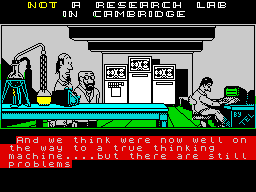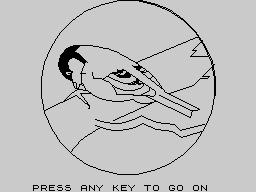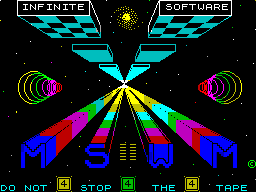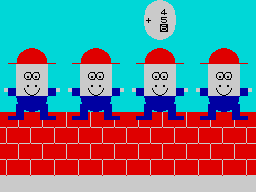

Tape magazines aren’t small beer nowadays. Argus Press Software publishes two titles for the Spectrum, and also covers the Atari, Commodore, Amstrad and MSX. If you added up all the tapes duplicated by APS for all the issues of its magnetic magazines in a year, the figure you’d end up would be very big indeed. Big enough to make them one of the largest software houses around.
Three other fish swim in the Spectrum tape magazine sea as well, so we take a look at no less than five potential competitors on these pages... fearless ain’t we?
Shortly after the first home computer that could load from and save to cassette tape came into being, you can be sure that some bright spark had the idea of producing a magazine or club newsletter in software.
The Americans started the ball rolling, with a couple of magazines appearing on tape in the late seventies — and there’s never been a shortage of program listings in conventional computer mags for keenies to type in for themselves. Some listings publishers offer their readers the chance to buy a tape of ready typed in listings too as a supplement to the printed publication. It wasn’t until 1983, however, with the launch of Spectrum Computing and 16/48 that Spectrum owners were given the chance to leap on the magnetic bandwagon.

SPECTRUM COMPUTING’s long running animated cartoon strip.
Argus Press led the field, putting out the first issue of Spectrum Computing early in the year, and they were followed by an independent company, Magnetic Magazines Ltd who began publishing 16/48, and then sold the magazine to Argus Press after ten issues. Thus the two main cassette publications are now produced indirectly by a mainstream paper-and-ink publisher, but three independent tape magazines for the Spectrum are alive and kicking. MSWM (MicroSoftWareMagazine) is produced in Moseley, Birmingham, by Infinite Software; Magnetic Mag lives incommunicado in Romford, Essex and a new title for youngsters, Kiddisoft is being produced in Cornwall.
As a medium for publishing news, views and gossip, cassette tape isn’t that wonderful — you’d need an awful lot of tapes to store one issue of CRASH, and it’s not that easy to flip through a cassette mag in the bath or on the bus... no, we’re not too worried here in CRASH Towers.
But they do have a definite advantage in that programs contained in a tape mag are loaded straight into the computer — no longer do you have to spend hours typing in a tedious magazine listing only to find that the gumby who wrote the game managed to diddle £20 out of the magazine publishers for a rotten game not worth the wear and tear your keyboard suffered during the inputting. No, it’s all there, up front and loaded straight into your machine — and the commercially produced titles are now filling a gap in the software market, publishing quite good games that might otherwise never have seen the inside of more than a couple of Spectrum RAM chips.

Ho ho lolo, the Santa of SPECTRUM COMPUTING, makes a point familiar to magazine editors everywhere.
‘Programmers of intermediate ability can’t sell their work very easily,’ commented Roy Gibson, big cheese on Spectrum Computing, ‘and we provide an alternative outlet to magazine listings. It’s the same idea as printing the listings, but at least all our readers get to see a program we publish in the magazine. Not everyone will go to the bother of typing in a listing published by a conventional magazine.’
In many ways, tape magazines tend to be more ‘clubby’ in nature than their printed counterparts. MSWM is published by the Microsoftware Club in Moseley and is meant to be a means of communication between club members — ‘one thing that we all have in common is that we all own a Spectrum, an ideal means of communication’ as they say themselves in Issue 6. As with all magazines, the tape ’zines encourage readers’ letters, and there’s quite a lively exchange of tips and hints to be found in all of them. MSWM has a deliberate policy of leaving all their programs in listable form, and of filling them with REMarks. Readers are encouraged to break into the software, examine it and learn more about their machines as a result.
The content of the MSWM magazines that we got to see was generally interesting and strongly reflected the club nature of the publication. Their readers merrily swop hints and tips and send out appeals for help via the magazines ‘pages’, while the editorial team provide features on programming and getting the most out of your Spectrum. There’s a positive ‘we’re all in this together’ club feel to MWSM, and it makes you want to join in...
And that’s perhaps the major appeal of tape ’zines — they are an ideal medium for communicating slightly more technical information, as a tutorial feature can actually demonstrate the theory as part of the presentation rather than relying on the reader to type in acres of code, debug it and then refer back to the printed page. The straight entertainment side, games programs, reviews and editorial pieces themselves are not exactly rubbish, either...

The great tit. Need we say more? Should we say more? From the KIDDISOFT Nature trail.
Roger Swift, who started 16/48 and now produces it for Argus Press Software pays between £20 and £100 for a program published in his magazine: ‘We provide an outlet for games which are not megagames, and are becoming a market for people who can write games which provide our readers with an example of what they could do on their computers, Nowadays I’m rejecting material that I’d have been delighted to receive a year ago — the standard of submitted work has improved enormously.’
And Roy Gibson of Spectrum Computing takes a similar view: ‘The amount of material generated for the Spectrum is massive, and we fill a nice little gap between the Top Ten commercial aspirants and the type-it-in-yourself-from-a-magazine-listing brigade.’
Magnetic Mag remains firmly anonymous — their ’phone number is ex-directory, and two separate letters failed to elicit any kind of response from them. You might, therefore, be a little reluctant to send off the £2.50 they ask for an issue! Enough of them!

In case you couldn’t work it out, the title screen from MSWM.
The lady behind Kiddisoft is, however, quite happy to answer the ’phone and explained that her magazine is a new venture, aimed at youngsters between the ages of four and eight. Anne Menneer has a degree in Psychology and is a trained teacher too. Her tape magazine is intended as a comic: ‘slightly educational, and fun’, and should come out monthly after the first few issues.
‘Edu-tainment’ is one of those horrible compound American words used to describe entertaining educational programs. And in a way that’s what Kiddisoft sets out to provide in a magazine format. Overall, Issue 1 is a jolly package of games, which could do with a bit of polishing — while the graphics in some of the games could do with a little more thought (or programming skill), the game content was good. The simplified adventure, which asks the player to choose between options rather than dream up and input commands, was particularly attractive, with pretty graphics and an appealing storyline, if a little repetitive (you could visit and re-visit corners of the program endlessly, doing the same thing every time).

Save the KIDDISOFT Humpties; get the sum right, and Humpty won’t fall!

The balloon game — a cheerful little challenge from KIDDISOFT.
The first issue of the Kiddisoft magazine is indeed a worthy pilot. All the programs are in BASIC, and have been written ‘in house’. Once the magazine builds up a readership and starts receiving programs and letters from outside contributors it could easily make quite a comfortable niche for itself in the educational market. Meantime, we’re passing our copy over to Rosetta McLeod....
16/48 is a monthly magazine, and as its title suggests, is aimed at both users of the 16 and 48K machines. Roger Swift set it up back in 1983 and published ten issues of the magazine before deciding to accept Argus’s offer to buy out the title — largely because the business side of the operation became too much hassle.
16/48 is put together every month by Roger and two colleagues — an adventure columnist and graphics whizz by the name of Yaz, and Barry, who writes the serial adventure Ludoids and the odd piece of machine code. And of course, there are the readers’ contributions.
The Ludoids adventure is a particularly neat idea on the part of 16/48 — a 48K text with graphics adventure which started in issue 14. You can play each month’s game on its own, but can play through the serial as you are given a code on successful completion of each month’s instalment which you can use to kick off with on the next ‘chapter’. And of course the magazine is in a strong position when it comes to offering help on previous chapters of the continuing adventure....
Despite the title, 16/48, like the majority of Spectrum tape magazines no longer worries too much about having to cater for owners of the 16K machine — there’s not that many of you left, it seems!
The June issue contained the usual editorial and contents pages, reviews, a crossword and competition, and a continuation of the magazine’s machine code course. A neat explosion routine was also supplied, explained and demonstrated, and offered as a utility for inclusion in readers’ programs.
On the games front, a competently programmed machine code platform game lived on side One, which lost out on playability a bit by being too pernickety, and a golf simulation lurked on side Two which could have provided hours of enjoyment for some people....
The May/June issue of Spectrum Computing which is about to go monthly, was slightly better equipped with games, featuring a neat and compelling machine code arcade game called Piggy, a rather pretty but fiendishly difficult maze game and a very tidy implementation of Cribbage. Why anyone should bother to program Solitaire as a computer game is a little beyond this ’umble reviewer, but someone did, and now you can own a copy by getting hold of this issue of S.C.!
Reviews, a chirpy editorial and the regular animated cartoon also appear on the tape with a column by Wizard Prang who is the resident machine code expert/tutor.
Spectrum Computing has recently changed editor, and will now be produced from a bungalow in Merseyside by Roy Gibson, having lived up till now in Iolo Davidson’s farmhouse. Roy plans to change the magazine’s emphasis from a contributor-driven publication to one that picks a subject each issue, and involves contributors more directly in the advance planning of the magazine. Roy makes a point of always criticising submissions constructively, sometimes writing a little machine code routine to improve the original program, or referring the programmer to appropriate reference books.
Both 16/48 and Spectrum Computing feel that the core of their readership lies with the more serious Spectrum user and less with the committed arcade player. Consequently in coming months the emphasis is likely to move towards supplying more material on the machine code and utilities front, while continuing to publish games programs as ‘freebies’.
Of course, there’s no real reason why tape magazines shouldn’t include taped interviews with people in the software industry, or indeed combine recorded sound with software in the same devious way as Softlee Systems have with their educational software (see this month’s CRASH COURSE). The possibilities are endless, and they certainly serve a complementary function to the traditionally produced, hard copy computer magazine.
A subscription to one of the tape magazines would provide a regular fix of software and technical information, and should go down well with any serious computer user. But the game player has a lot to gain from tape magazines too — for the price, they’re hardly a rip-off, each containing at least a couple of perfectly respectable budget games, together with features presented in a clubby manner. Worth checking out.